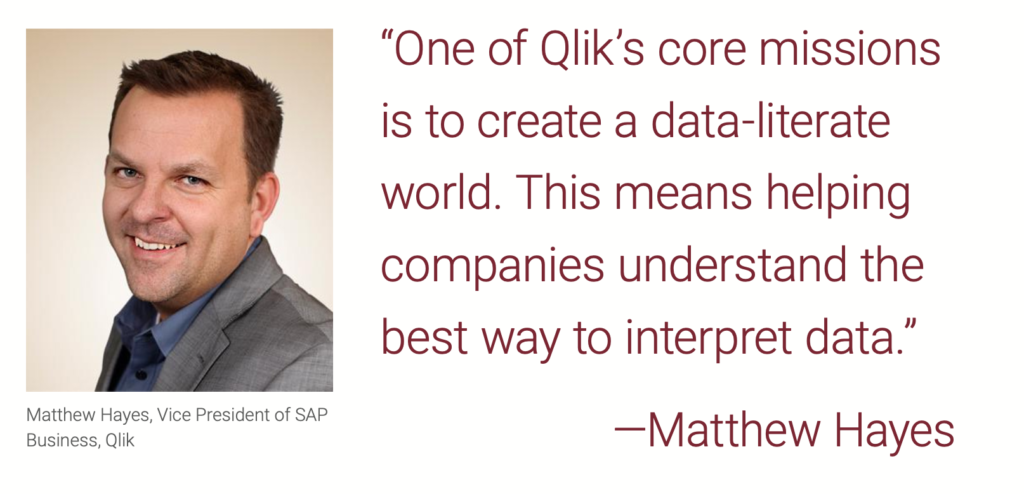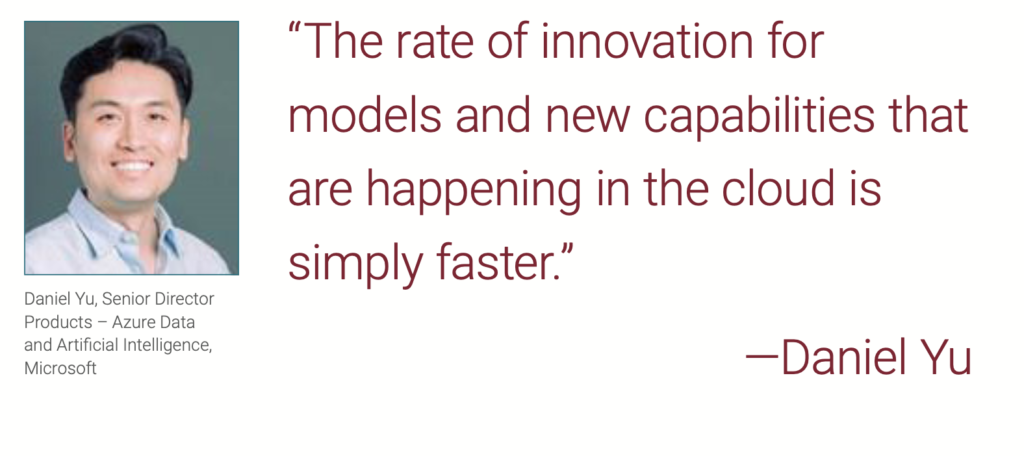Realizing Value from your Cloud & SAP Journeys
By Joe Mullich, Contributing Writer, SAPinsider
If poet John Donne were alive today, his famous line might read, “No data is an island.” While SAP systems contain some of the most valuable information available to an enterprise today, increasingly the true value of that data is realized by combining it with other information stores.
“Companies want to unleash the value of their data, and the value of their analytics,” says Daniel Yu, Senior Director Products — Azure Data and Artificial Intelligence at Microsoft.
Explore related questions
“Companies want to marry all their data that exists in all the different places, from Internet of Things (IoT) devices to the back office to the web systems they manage,” Yu says. “Bringing together data in your campaign management system running in the cloud with your supply chain data requires you to bring together data in near real time. In this way, you can not only make decisions faster — you can make decisions before your competitors do.”
There is no end of ways that companies can benefit from blending SAP ERP data with non-SAP source data.
For example, most companies with SAP also use Salesforce for customer relationship management (CRM). At some point, the order data history in SAP converges with the CRM data in Salesforce.
Or, consider a beer company running a Superbowl ad that needs to combine its SAP data with social media data, says Matthew Hayes, Vice President of SAP Business at Qlik, a leader in real-time data integration and analytics. “The company might benefit by measuring the marketing return on investment (ROI) of the Superbowl ad and different targeting strategies by combining real-time social media data with online sales orders. Marrying customer sentiment to SAP creates more insights.”
Order-to-cash — a critical but complex process that spans multiple functions, teams, and systems — is also ripe for combining SAP and non-SAP data. Companies want to collect payment as soon as possible after an order is booked. However, collecting payment depends on how fast an order is fulfilled, how quickly the bill
is sent, and how well accounts receivables are managed. If the systems are different and disconnected, the inevitable result is inefficiencies in collecting payments leading to higher operating and working capital costs.
To help organizations optimize order-to-cash operations and working capital, Qlik recently introduced solution accelerators for order-to-cash analytics. Qlik provides a blueprint for SAP data integration with modern analytics projects as well as pre-built data integration and analytics components — the accelerators — that work hand-in-hand with cloud technology partner offerings from Snowflake, Amazon Web Services, Microsoft Azure, and Google Cloud to speed delivery of business solutions and data modernization projects. The accelerators save time and costs in the effort and configuration required to fit into a customer’s SAP deployment.
The order-to-cash accelerators extract and upload SAP data in real-time to the cloud platform of choice, allowing the data to be applied to cloud analytics and consumed by users more easily. As a result, companies can improve sales order booking and fulfillment, optimize days outstanding, manage working capital better, and increase efficiency with insights into billing errors, order returns, and bills processed per hour.
Choose Architectural Direction Carefully
Qlik’s end-to-end platform enables companies to make use of the analytics capabilities of different cloud vendors. “The analytics journey is evolving rapidly, and can materially impact your business,” Hayes says. “The irony is that SAP data becomes more valuable if you expand it with related data from other sources.”
Hayes says SAP has provided valuable software to its customers over the years, especially related to transactional processes. And when it comes to next generation business intelligence (BI) or analytics, customers have a plethora of options that they should explore. “A lot of ERP software is fantastic,” he says, “and it can be enhanced using solutions that are strong in IoT, artificial intelligence (AI), machine learning, and analytics capabilities.”

According to Hayes, companies need flexibility and autonomy in choosing their architecture direction in order to advance a specific analytics project or their overall analytics journey, based on a vision that includes both SAP data and non-SAP data.
“If you run SAP on-premise, that technology can allow you to leverage all the resources you need,” Hayes says. “But the minute you go outside that box, and make use of cloud-based services and other tools, you’re now bringing in other options. That means you have the power of SAP as a vendor, and you’ve got the power of the cloud solutions.”
“With cloud applications, you have access to thousands of machines in the cloud so you can run massive calculations for forecasting or inventory management across all your subsidiaries and only pay for the capacity that you use without paying to buy the machines,” Yu says. “You can immediately turn that information into predictive models, BI reports, actions, and share that information with vendors or partners. The rate of innovation for models and new capabilities that are happening in the cloud is simply faster.”
In the past, getting SAP data into a cloud environment was challenging because of the inherent complexity and proprietary nature of SAP applications and respective data models and systems.
The Qlik Data Integration platform removes the business and technical challenges of complexity, time, and cost. Yu explains how this works in tandem with Microsoft: With its proprietary technology, Qlik Data Integration quickly maps SAP business processes and effortlessly creates Azure Synapse schemas and calculations. This enables organizations to go from raw data to quickly discovering actionable insights in Azure Synapse, an integrated analytics service that accelerates time to insight across data warehouses and big data systems.
In addition, Qlik Replicate provides change data capture (CDC) capabilities that move data in real-time through a simple graphical interface which completely automates end-to-end replication. As a result, data engineers can easily set up, control, and monitor data pipelines with ease, keeping records in real-time, and in constant sync between SAP and the cloud environment. Qlik Compose automatically transforms SAP processes and apps that Azure Synapse can instantly understand, allowing the SAP data to be used quickly and easily for analytics insights.
“The cloud and SAP journeys are complementary on the usage but orthogonal on the architecture,” Yu says. “SAP systems are really good at managing transactions you need to run your business. Analytics is best when you try to map different data from different sources, connecting your own data with your partner’s data, with data from a third-party system to make predictions about inventory. That requires a different type of software, from BI to data lakes tools.”
Building Trust Throughout the Enterprise
Despite such technical advances, Hayes says he often encounters analytics project teams being dissuaded from taking data out of the SAP solutions by the SAP technical team in their company. “They’re really skeptical of third-party technology, or they really want us to use SAP tools to access the data,” he says. “So we have to build trust between the analytics project team and the SAP team.”
Without such trust, he says the SAP team might simply default to solutions that they’re familiar with rather than considering which solution is the best fit for the company. “When that happens, you run the risk of complicating the architecture and creating two points of failure,” Hayes says. “It’s important to not have the knee jerk reaction of saying we have to use SAP stack solutions. Sometimes, it’s better to put the project needs and requirements first, then select the best technology to meet those requirements.”
Avoiding such issues depends, in no small measure, on coordinating technology initiatives as well as mindsets within the enterprise. At most companies, cloud directives are usually driven at the CIO level. Hayes notes that the digital transformation strategy around SAP is typically run by an SAP program manager or officer. As SAP workloads move to the cloud, Hayes says that companies should see those initiatives as the same thing, or at least complementary, rather than as separate projects.
“If you keep them separate, you run the risk of people making decisions that are at odds with each other,” he says. “You may have an SAP initiative pushing an SAP cloud solution. Meanwhile, you may have a CIO being courted by other cloud-centric vendors or hyperscalers to use their cloud offerings. By the time
you figure out that you’ve made decisions that are at odds with one another, you could be pretty far down the path.”
Companies can help avoid these disconnects by developing a concrete vision for the analytics program. Hayes points to a poultry manufacturer that spent $3 billion a year on corn. By optimizing its supply chain and mining micro-efficiencies, it realized it could save $150 million on the bottom line. With that goal in mind, the company could select the right technology architecture to support it, and it achieved the targeted cost savings. Not every company starts with such a clear vision, but most have a similar goal.
As companies consider their cloud journey and their SAP digital transformation journey, they should begin with firm objectives in mind. It’s critical to ask specific questions: Do you want to lower costs? Increase revenue? Improve business efficiency? Gain more market share and create a competitive advantage?
Without knowing where you want to get to, it’s hard to choose the right path.
Making the Leap
By having this firm focus, companies can advance their SAP journey and their analytics journey. The biggest leap is the initial leap from traditional reporting to meaningful dashboards that provide a flexible way to visualize and drill down into data. “That’s the first bridge that needs to be crossed. From there, you can expand capabilities depending on the solution you’ve selected,” says Hayes. And those capabilities can be extensive, such as alerting capabilities and conversational analytics.
Hayes explains how a deeper approach can turn into real-world business benefits. “A sales rep that hasn’t seen a customer in two years could benefit from pulling out his tablet and typing ‘what revenue did Acme Chemical do with us in the last three years?’ If the rep sees that the customer has increased its spend by 40%, that’s really valuable information. It changes the flow of the conversation from what it would be if the spend had gone down.”
The key to achieving benefits is real-time reporting, so decisions are made not just by looking back at past events. “The expectations today are much broader than just give me a dashboard — dashboards are easy,” Yu says. “That’s just an aggregation of the past. They want real-time data that can shape the future. Supply chains organizations, who are probably the biggest consumers of analytics, feel like they don’t have enough analytics. They know how much inventory turnover they have, but there is no detail, and they can’t see the reasons for turnover. They need to bring together human data, with sensor data, with partner data, to get that detail in real time. That allows them to not only predict, but to change the way they do business.”

These abilities must be spread widely throughout the organization. “You should treat data as you treat money,” Yu says. “You wouldn’t hire a supply chain manager that doesn’t understand just in time concepts or an accountant who didn’t understand modern revenue principles. In the 21st century, data is as important as those skill sets. Companies need a curriculum to help employees understand analytics concepts.”
In a time when data stockpiles are exploding, as are cloud, analytics, and technology options, it can be tempting to cling to historic approaches and notions. However, increasing competitive pressures mandate that companies think more broadly and break down silos — and not only silos of their data — but silos of perceptions and individual teams within the organization.
“One of Qlik’s core missions is to create a data-literate world,” Hayes says. “This means helping companies understand the best way to interpret data.”
Hayes shares an analogy to a baseball fan drafting his fantasy team. He has access to a tantalizing amount of information, but as the draft date approaches, having quick access to the best, most concise information is what’s needed. “When it’s crunch time, it doesn’t help you to have a bunch of data that you don’t know what to do with,” he says.
From an enterprise standpoint, this means having data that is organized and presented in a way that provides immediate, valuable insights. However, it also means being open to using the vast amount of technology options, and choosing the option that meets your specific challenge. “In the end, it’s your data and choosing how you want to leverage that data can be transformational.”
To learn more about Qlik Solutions, visit their Partner Showcase.




